Nocturnia
Johnny Wu, Matthew Gruber, Zain Islam-Hashmi
December 6, 2015
<https://youtu.be/_JC0-dpsvfo>
Abstract
The mission of our project was to teach the concept of being nocturnal to young children. Our idea was to vividly display the diverse amount of creatures that are active at night that children might not get the chance to see. We created a table filled with light responsive creatures. These animals would only become active with servos and LEDs when a shadow was cast over them, simulating the night time. The table was successful, with the LEDs and animal activities engaging children’s’ interest. While there were some minor bugs and troubles that are inevitable with such a first major project, these errors were corrected and provided minimal impact in regards to the children’s interest. Some children had favorite animals on the table, and they seemed to understand that they were “night creatures”.
Objectives
Our core goal was to demonstrate the notion of nocturnal animals to young children. To achieve this goal, we implemented carefully chosen features. The features within the scope of the project included a rotating light to simulate the day-night cycle. There were also animals that responded to shadow with servo-assisted movement and activation of LEDs for greater impact in the dark. These features in combination demonstrate the conditions for nocturnal activity, but also present it in a colorful and engaging way so children would be interested.
Implementation
The table was octogonal, as the shape would be simpler to fabricate than a smooth circle but more interesting than a regular square. The height was 1.5 feet to ensure that children could easily see and access the table. The light was 5 feet tall, to reduce the chance of children potentially grabbing or burning themselves on the light. The various animals we included were mounted on servos for movement and also had LEDs to further show activity but also for colorful immersion. We included some predator-prey pairs for the more astute children. In addition, the base plate of the table was colored various shades of green to simulate grass, and the material for the animals were chosen based on their color. Clear acrylic was a common material because of it’s versatility and the endless color and design possibilities achieved with paint. The rotating light was constructed with cardboard to reduce weight.
Outcomes
The outcome of the project was overall a success. A full version of the table was fabricated, interactive features were wired and included, the prototype was somewhat successfully installed, and meaningful interactions between the artifact and children/users were able to occur. Some challenges were faced with putting together the prototype, such as the power source/supply to the Arduinos and various motors, as well as a few wiring flaws and creatures not responding/functioning. However, these factors did not deter from children being able to interact with the table and see it in a working state. The table was able to attract a small handful of children for the short time that it was running. Many kids were curious of the table from afar and approached it cautiously, at first gazing from it from the edge. However, children would start to lean in forward to see the entire table and its creatures, and that was when a shadow would be cast from their entire bodies and the sensors and LED’s would activate. After this step of realization, the children were noted to move there hands much slower and graciously above the table, as opposed to fast and quickly directly on the acrylic (these children were around the ages of 4-6). Smaller children, such as in the 2-4 bracket, has a hard time seeing the table sometimes, but they were the ones who would hit the table immediately and stuck their hands inside the curtain to take creatures (this occurred twice). The children seemed to especially enjoy the bat and owl, as they had the most movement and colorful lights that gained the children’s attention. Average interaction was around 10-30 seconds.
Contribution
Johnny Wu concentrated on overall planning/some designs and construction of certain animals and flowers, as well as the rotating light. Matthew Gruber focused on the wiring and programming of the project and helped with various construction and design tasks. Zain Islam-Hashmi’s focal point was with the construction of the overall table, as well as assorted fabrication work.
Photo Documentation
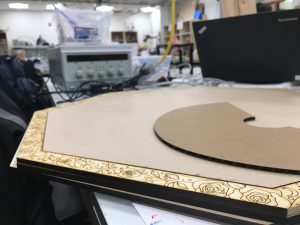 (Prototype of table top using laser cutter)
(Prototype of table top using laser cutter)
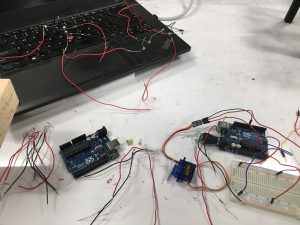
(Rough wiring of sensor to LED/Servo)
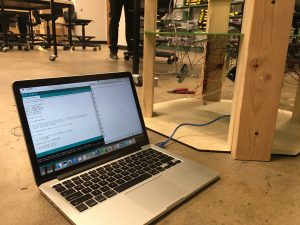
(Underside of table and prototype’s wiring hookup)
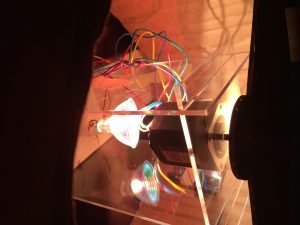
(Rotating Light hookup)

(reaction after successfully achieving rotating light mechanism)

(live interaction photo)
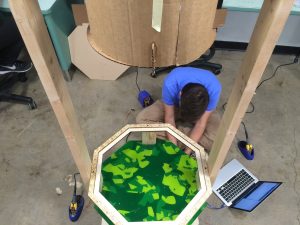
(prototype in progress)
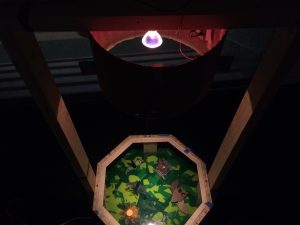
(prototype installed)
Circuit Diagram
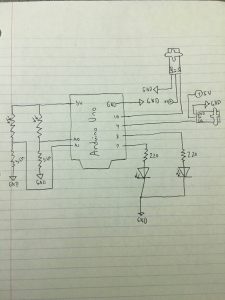
*We had essentially 3 of the same series of circuits. Each input 7 and 8 had multiple leds anchored to it however I only put 1 for simplicities sake*
Code
Citations
Our project took inspiration from “Ephemera” by Austrian-firm Mischer’Traxler (https://www.mischertraxler.com/projects_ephemera.html).
Leave a Reply
You must be logged in to post a comment.